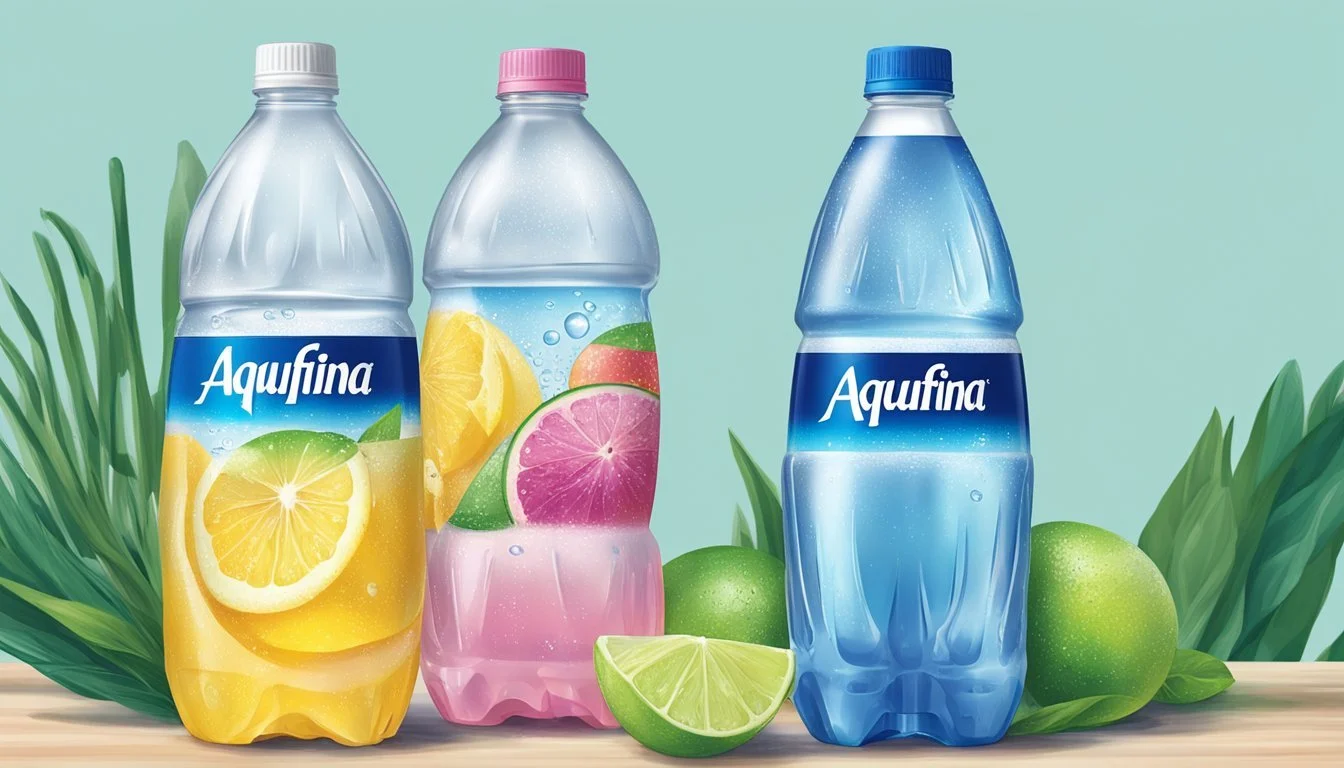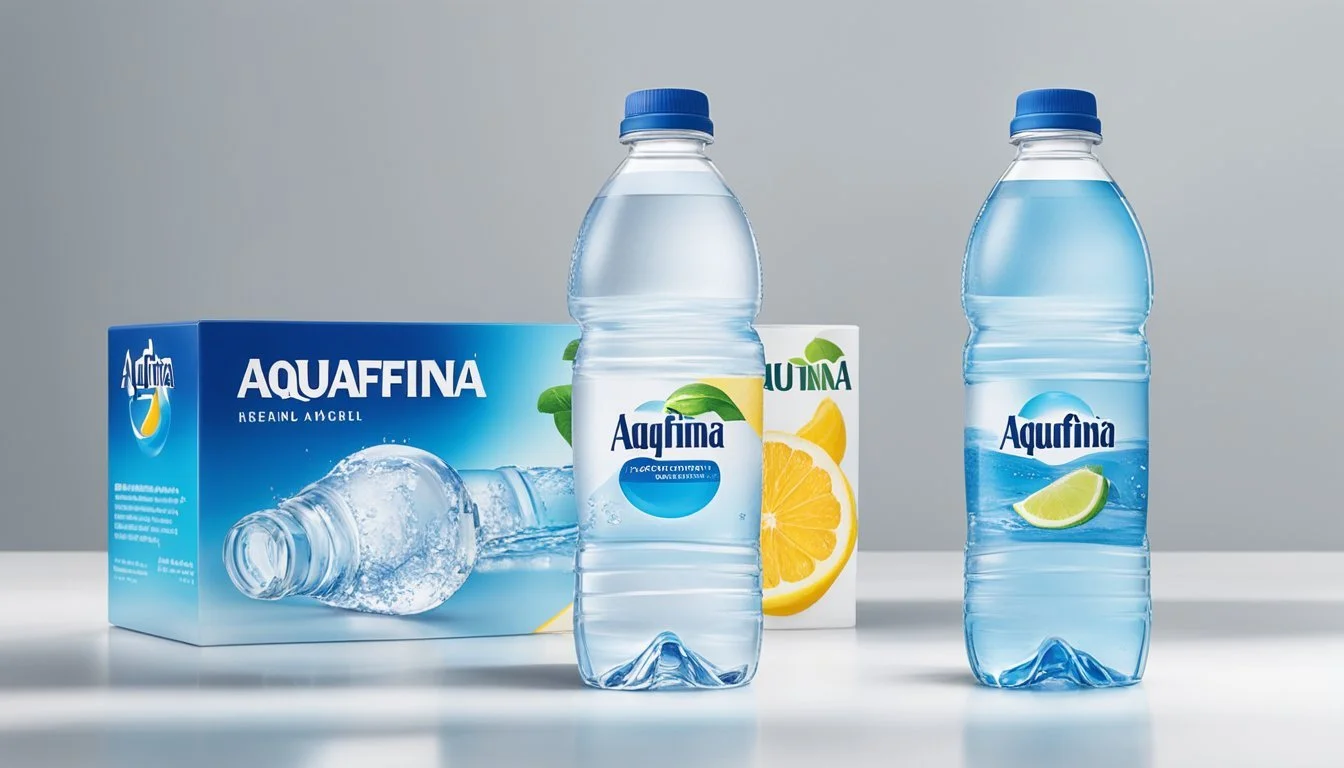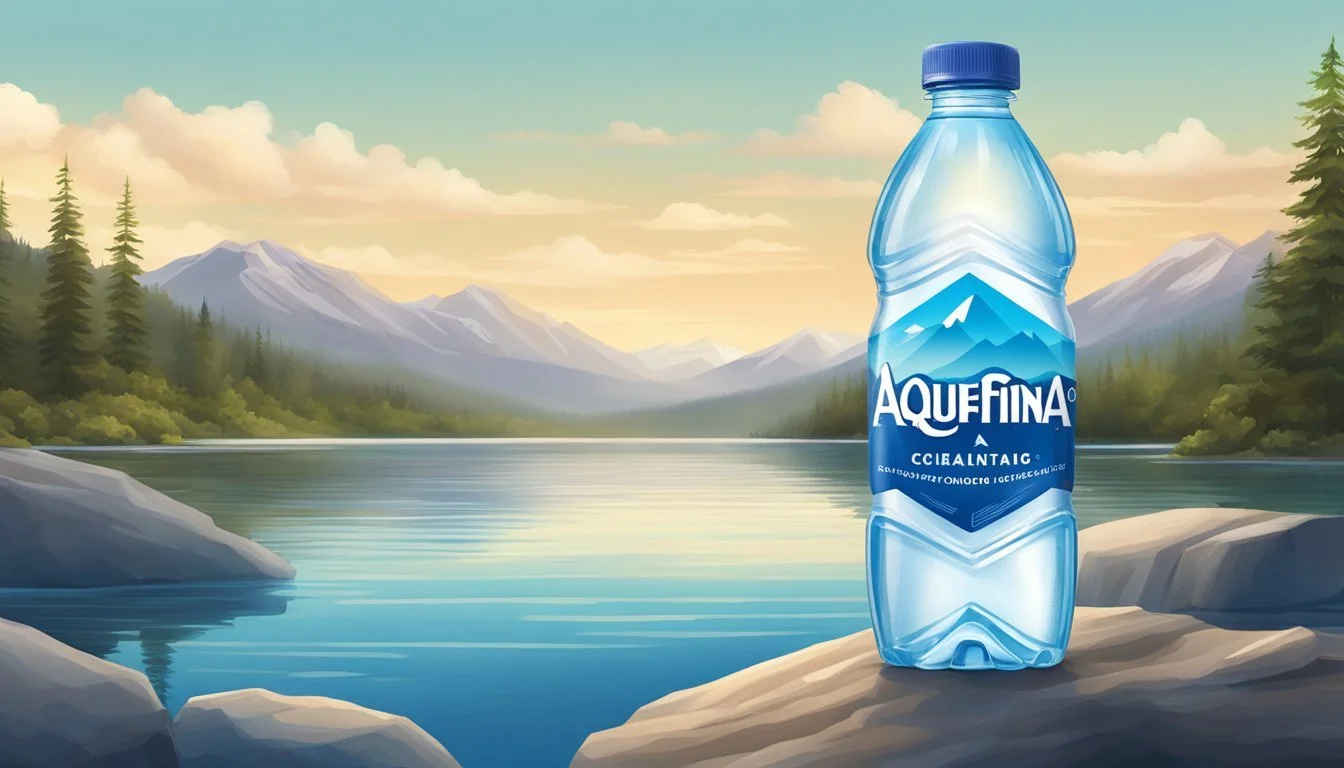Aquafina vs. Augi
Comparing Purity and Taste
Choosing the right bottled water can make a difference in your daily hydration routine. Aquafina, produced by PepsiCo, is renowned for its purity achieved through a rigorous seven-step purification process. On the other hand, Augi, though newer on the market, touts a naturally sourced water profile with minimal processing.
Aquafina's extensive purification process gives it a clean, crisp taste that appeals to those seeking assured quality and reliability. Augi emphasizes natural hydration, drawing from pristine sources to offer a fresh taste unaltered by heavy filtration.
Understanding the distinctions between these two popular brands can help consumers make an informed choice that aligns with their preferences for purity, taste, and source.
Understanding Bottled Water
Bottled water comes in various types with different sources and treatment processes. The safety and quality of bottled water are governed by strict regulatory standards to ensure consumer safety.
Different Types of Bottled Water
Bottled water can be classified into several types, each with distinct characteristics. Spring water flows naturally to the earth's surface and is collected directly from the spring. It retains its natural minerals and taste, often heralded for its refreshing qualities.
Purified water undergoes processing to remove impurities and contaminants. Common methods include distillation, deionization, and reverse osmosis. This results in water that is free from most contaminants but may lack the natural minerals found in spring water.
Mineral water comes from a mineral spring and contains various minerals, such as calcium, magnesium, and sodium, which are beneficial to health. These minerals occur naturally, and the water must maintain a consistent level of these elements.
Artesian water is drawn from a confined aquifer, which is a deep underground layer of water-bearing rock or sand. This type of water is under natural pressure, which allows it to rise above the level of the aquifer when tapped.
Regulatory Standards for Bottled Water
The safety and quality of bottled water in the United States are regulated by the Food and Drug Administration (FDA). The FDA sets standards to ensure bottled water is safe for consumption, similar to the standards the Environmental Protection Agency (EPA) sets for municipal tap water.
The FDA regulations cover several aspects, including contaminant levels, source protection, and labeling. Bottled water must meet rigorous standards for microbiological, physical, chemical, and radiological safety.
Manufacturers must adhere to Good Manufacturing Practices (GMPs). These include sanitary conditions, proper plant and ground maintenance, and employee hygiene practices, ensuring the bottling process does not introduce contaminants.
Bottled water producers are required to conduct source water assessment programs. This helps ensure that water sources are protected from contaminants and are regularly monitored. Labels on bottled water must be truthful and not misleading, providing clear information about the source and treatment processes.
Aquafina: Brand Overview
Aquafina, a product of PepsiCo, is renowned for its stringent purification process and clean taste. It appeals to health-conscious consumers and those seeking high-quality hydration.
Source and Purification Process
Aquafina sources its water from public water sources, ensuring an accessible and consistent supply. The brand emphasizes its intense purification process, which includes reverse osmosis and other filtration methods. This seven-step HydRO-7 process removes chlorine, salts, and other impurities.
The thorough purification results in high-quality, purified water that meets stringent standards. Consumers trust Aquafina for its commitment to purity, making it a popular choice among bottled water brands.
Taste Profile
Aquafina is often praised for its neutral taste and lack of aftertaste. The rigorous purification process results in water that is clean and crisp, without the mineral taste found in some other bottled waters.
The absence of added minerals contributes to its pure flavor. Consumers looking for a refreshing and straightforward drinking experience often prefer Aquafina for its simplicity and clean finish.
Health and Hydration
Aquafina positions itself as a healthy and hydrating option. The brand ensures that the purified water maintains a balanced pH level, which is important for overall health. Hydration is key for bodily functions, and Aquafina’s high-quality water supports proper hydration.
PepsiCo promotes Aquafina as part of a healthy lifestyle, appealing to those who prioritize wellness. The brand's focus on purity and quality helps it stand out in the crowded bottled water market.
Competitor Profile: Augi
Augi is an emerging player in the bottled water market, acclaimed for its commitment to purity and mineral-rich content. This section details Augi's source, flavor profile, mineral content, and potential health benefits and concerns.
Source and Quality
Augi sources its water from natural springs located in pristine, mountainous regions. The water undergoes minimal processing to maintain its natural composition. This ensures high-quality standards, with strict monitoring for contaminants and pollutants.
Each batch of Augi water is tested for clarity, taste, and purity, meeting rigorous safety and quality standards. The purity of the source is a key selling point and contributes to the water’s overall reputation for high quality.
Flavor and Mineral Content
The flavor of Augi water is characterized by its clean, crisp taste, attributed to its natural spring origins. It contains a balanced mix of minerals such as calcium, magnesium, and potassium.
This mineral blend provides a slightly alkaline pH, known to enhance flavor and potentially benefit hydration and metabolism. The presence of these minerals can also impart a subtle, pleasing taste, devoid of the metallic or plastic undertones found in some other brands.
Health Benefits and Concerns
Augi water is often praised for its potential health benefits, primarily due to its balanced mineral content. Electrolytes like calcium and magnesium are present, aiding in bone health and muscle function.
However, it’s important to consider the overall mineral intake from all dietary sources to avoid excessive consumption. Although generally safe, individuals with certain medical conditions should consult healthcare providers to ensure the water’s mineral content aligns with their health needs.
Comparative Analysis
When comparing Aquafina and Augi bottled water, several key factors come into play. These include the purity and safety of each brand, their environmental impact and sustainability practices, and their pricing differences.
Purity and Safety
Aquafina utilizes a rigorous HydRO-7 purification process which includes seven steps to remove contaminants. This extensive filtration is touted as reducing more substances than many other brands. Notably, Aquafina claims that its process ensures high levels of purity, free from common impurities and PFAS chemicals.
Augi Water, a newer player in the bottled water market, also prioritizes purity. They use an advanced filtration methodology focused on eliminating harmful substances and impurities. Augi advertises their water as being free from microplastics and having low total dissolved solids (TDS), aiming to offer a clean and crisp taste.
Environmental Impact and Sustainability
Aquafina, a well-established brand, has made strides in improving its environmental footprint. Their efforts include using recycled plastic (rPET) in their bottles and encouraging recycling. PepsiCo, Aquafina's parent company, has set ambitious goals for reducing plastic usage and increasing packaging recyclability.
Augi Water markets itself as an environmentally friendly brand. They use biodegradable and easily recyclable materials for their packaging. Additionally, Augi emphasizes low-carbon footprint production processes and sustainable water sourcing. This positions them as a more eco-conscious choice compared to traditional bottled waters.
Price Comparison
Aquafina is generally positioned as a mid-range option within the bottled water market. A standard 24-pack of Aquafina can be found in most supermarkets for a moderate price, reflecting its extensive purification process.
Augi Water, being a newer niche brand, tends to command a higher price point. This premium is attributed to their sustainable practices and high-purity filtration. Consumers who prioritize environmental sustainability and advanced purification methods may find the higher cost justifiable.
In comparing Aquafina and Augi, each presents unique advantages in purity, environmental impact, and pricing.
Consumer Perception and Brand Reputation
The reputations of Aquafina and Augi in the bottled water market largely shape consumer perceptions. Various reports and reviews highlight key differences between the two brands.
Market Presence
Aquafina, owned by PepsiCo, has a robust market presence, recognized as a major player in the bottled water industry. Its wide availability in supermarkets and convenience stores makes it an accessible choice for consumers.
Augi, while less ubiquitous, is known for its unique branding and niche market appeal. This brand leverages its artisanal image and specific sourcing to attract a discerning customer base. Despite its smaller market share compared to Aquafina, Augi maintains a strong identity that resonates with a segment seeking premium bottled water options.
Consumer Reports and Reviews
Consumer reports consistently acknowledge Aquafina for its purity, attributed to a seven-step purification process. This process contributes to its favorable reputation among consumers who prioritize clean and safe drinking water. Reviews often mention its consistent quality and neutral taste, making it a reliable choice.
Augi, praised for its distinctive taste, often draws comments for its unique mineral content and source. Although its artisanal claims enhance its prestige, some reviews note its higher price as a potential drawback. Consumer feedback frequently emphasizes the crisp and refreshing profile of Augi, which sets it apart in taste tests against more mass-market brands.
Health and Hydration Factors
Choosing the right bottled water involves more than just taste; it requires evaluating hydration efficiency and the presence of crucial electrolytes and the pH level of the water.
Hydration Efficiency
Hydration efficiency is key to maintaining health. Both Aquafina and Augi claim to provide superior hydration due to their purification processes.
Aquafina undergoes a rigorous purification including reverse osmosis, which removes impurities. Augi, on the other hand, emphasizes its naturally sourced water, preserving minerals that aid in hydration.
Consumers often find Aquafina's taste crisp and clean due to its purification. Augi's natural source might offer a more authentic water taste with a slight mineral presence, which some may prefer. Both aim to satisfy hydration needs effectively, though personal preference and daily hydration goals may guide choice.
The Role of Electrolytes and pH Level
Electrolytes such as sodium, potassium, and magnesium play a critical role in overall hydration. While Aquafina does not add extra electrolytes, it relies on its purification process to present clean water. Augi may naturally contain electrolytes beneficial for hydration.
The pH level also matters. Aquafina's pH is typically neutral, around 7, making it ideal for most individuals. Augi's pH could vary slightly depending on source and bottling, potentially offering alkalinity benefits.
Understanding the balance of electrolytes and pH levels helps in choosing the most suitable bottled water for personal hydration needs.
Innovations in Bottled Water
Recent advancements in bottled water focus on adding beneficial ingredients and employing sophisticated filtration and sterilization methods. These innovations aim to offer consumer-enhanced health benefits and elevate the overall quality and safety of the water.
Enhanced Waters and Additives
Bottled water brands have begun to enhance their products by adding minerals and other beneficial compounds. Core Hydration and Smartwater lead the way with added electrolytes and minerals like calcium, magnesium, and potassium, which can aid in hydration and overall health.
Some brands also infuse their water with antioxidants and vitamins, providing extra benefits beyond simple hydration. For example, certain Smartwater varieties include added electrolytes for taste and functional elements like antioxidants.
By incorporating these elements, these brands not only improve the taste of the water but also promote health and wellness among consumers.
Filtration and Sterilization Techniques
Advanced filtration and sterilization processes are pivotal in producing high-quality bottled water. Aquafina employs a rigorous HydRO-7 purification process that eliminates impurities and guarantees purity. This seven-step process includes multiple filtration stages to remove contaminants.
Ultraviolet (UV) and ozone sterilization are popular techniques to ensure the water remains free from microbial contamination. Ozone sterilization, in particular, is favored for its effectiveness in neutralizing bacteria and viruses without leaving harmful residues.
Reverse osmosis is another widely used filtration method, effectively removing dissolved solids, bacteria, and other impurities. Brands like Dasani use reverse osmosis combined with added minerals to enhance taste and ensure safety.
These advanced technologies ensure that the bottled water consumers drink is not only safe but also offers a refreshing and clean taste.
The Future of Bottled Water Industry
The bottled water industry is rapidly evolving, with several innovations poised to shape its future.
Companies are increasingly focusing on sustainability, using eco-friendly packaging and reducing plastic waste. Brands like Aquafina are investing in recyclable and biodegradable materials to minimize their environmental impact.
Recent trends highlight a growing consumer preference for hydration solutions that offer added health benefits. Enhanced waters, fortified with vitamins and minerals, are gaining popularity.
The industry is also witnessing significant technological advancements. Smart packaging, which includes QR codes for tracking water quality and source, is becoming more common.
Environmental concerns remain a critical issue. Consumers are demanding greater transparency about water sourcing and purification processes. Brands are responding by providing detailed information about their sustainability practices.
Incorporating renewable energy in production processes is another trend. Many companies are aiming to reduce their carbon footprint by using solar and wind energy.
The future will likely see a shift towards localized production to reduce transportation emissions, contributing to lower environmental impact. Regional sourcing of water could become more prevalent.
The integration of digital technologies and IoT can streamline operations and improve supply chain efficiency.
Moreover, as awareness about plastic pollution rises, there's a noticeable push towards alternative packaging solutions, such as aluminum cans and glass bottles, which are more environmentally friendly.
Overall, the future of the bottled water industry hinges on balancing consumer demands with sustainable practices and technological advancements.






